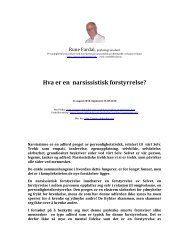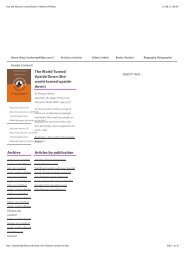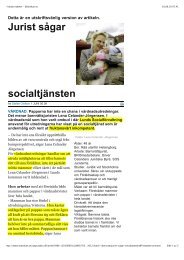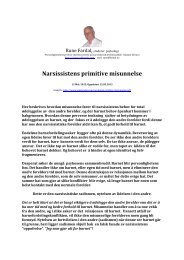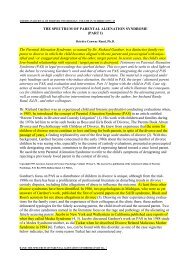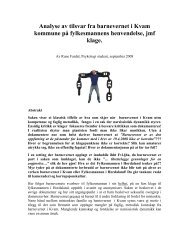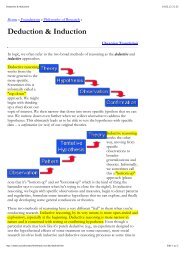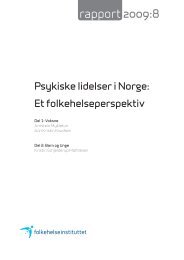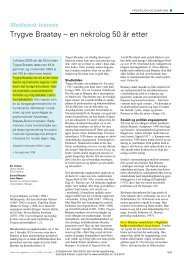The origins of narcissism and narcissistic personality disorder a
The origins of narcissism and narcissistic personality disorder a
The origins of narcissism and narcissistic personality disorder a
Create successful ePaper yourself
Turn your PDF publications into a flip-book with our unique Google optimized e-Paper software.
THE ORIGINS OF NARCISSISM 51<br />
<strong>and</strong> self-representation (the ego’s representation <strong>of</strong> oneself),4 this passage<br />
indicates that the psychical action that brings about <strong>narcissism</strong> is<br />
the infant’s forming a self-representation (see Balint, 1968/1979; Laplanche<br />
& Pontalis, 1967/1973). If autoerotism is an objectless state<br />
involving gratification from one’s own body, <strong>narcissism</strong> occurs when<br />
one can form an image <strong>of</strong> oneself or, rather, <strong>of</strong> one’s body (cf. Freud,<br />
1923/1961) <strong>and</strong> therefore can take one’s own body, for the first time<br />
regarded as a unified gestalt, as a love object. According to this reading<br />
<strong>of</strong> Freud’s theories on early development, the (body-)self is in fact the<br />
first love object (Smith, 1985). In consequence, self-overvaluation is<br />
fundamental to human psychological functioning (Freud, 1914/1957).<br />
Although autoerotism is usually considered to be objectless, several<br />
commentators (Balint, 1968/1979; Baranger, 1991; Henseler, 1991;<br />
Kanzer, 1964; Laplanche & Pontalis, 1967/1973; Smith, 1985) have<br />
noted that Freud had many reservations about placing an objectless<br />
state at the beginning <strong>of</strong> development. In Three Essays on the <strong>The</strong>ory<br />
<strong>of</strong> Sexuality, Freud (1905/1953) argues that sexual drive satisfaction,<br />
following the self-preservative drive, is originally attached to the mother’s<br />
breast, becomes autoerotic only when the infant becomes capable<br />
<strong>of</strong> forming a total image <strong>of</strong> the mother, <strong>and</strong> does not again seek an<br />
object until after latency. Several other passages suggest that Freud<br />
found troubling the notion that autoerotism <strong>and</strong> <strong>narcissism</strong> are objectless<br />
states <strong>and</strong> instead saw autoerotism as following an initial (selfpreservative)<br />
investment in an object (Freud, 1915/1957, 1917/1963,<br />
1923/ 1955). Freud’s reservations in this regard are crucial because they<br />
Because Freud used the German Ich to denote both ego <strong>and</strong> self-both the<br />
human subject <strong>and</strong> the subject’s conception <strong>of</strong> itself-H. Hartmann’s (1950)<br />
distinctions among ego, self, <strong>and</strong> self-representation are not without controversy<br />
(see, for example, Balint, 1968/1979; Kernberg, 1982; Laplanche & Pontalis,<br />
1967/1973). Specifically, Freud’s usage suggests a dialectical relationship<br />
between the ego’s agency <strong>and</strong> the ego’s capacity to represent itself, or invest<br />
in itself, as an object-a dialectic that some writers (e.g., Bach, 1985; Balint,<br />
1968/1979; Lacan, 1953; Laplanche, 1970/1976) hold is essential to underst<strong>and</strong><br />
<strong>narcissism</strong>. Hartmann’s terminology is adopted here because it has become<br />
st<strong>and</strong>ard (see, for example, Moore & Fine, 1990) <strong>and</strong> because it does<br />
clarify numerous passages (for example, the above selection from ”On Narcissism”)<br />
in which Freud apparently means ego as self or self-representation<br />
rather than ego as subject or agent. As this chapter argues, however, <strong>narcissism</strong><br />
results from a dialectical relationship between ego <strong>and</strong> self.




